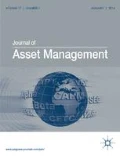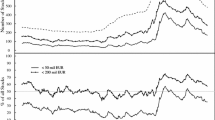Abstract
Various studies have shown that future stock returns are predictable based on past returns in many international security markets. Developing strategies to benefit from these autocorrelations of security returns and finding reasons for the abnormal positive returns resulting from trading strategies are major objectives of investment research. Following Jegadeesh and Titman, we analyze the profitability of momentum strategies in the Swiss stock market over the period from December 1979 until February 2009. Controlling for market returns and for transaction costs, we find that investors using momentum strategies could have indeed generated superior returns during that time period. This applies for several combinations of ranking and holding periods. In addition, we analyze for the first time whether the returns of momentum strategies involving Swiss stocks are industry-dependent. Our findings suggest that momentum in the Swiss stock market is clearly driven by high-technology stocks. The financial sector, in contrast, performs worst over that period of time.
Similar content being viewed by others
Notes
Since August 2008 the name of the Swiss stock exchange is SIX Swiss Exchange. Before the name was SWX Swiss Exchange.
For an overview of the components of trading costs, see Korajczyk and Sadka (2004).
The High-Tech sector encompasses Datastream's Aero Space & Defense, Alternative Energy, Pharmaceuticals & Biotech, Software & Computer Services, and Technology Hardware & Equipment sectors. The Services sector is comprised of the Electricity Fixed Line, Telecommunications, Food & Drug Retailers, General Retailers, Media Mobile Telecommunication, Support Services, and Travel and Leisure sectors. The Financials sector comprises the Banks, Financial Services, Life Insurance and Non-Life Insurance sectors. The Production sector encompasses the Automobiles & Parts, Beverages, Chemicals, Construction Materials, Electronic & Electrical Equipment, Food Producers, Foresting & Paper, Gas Water Multiutilities, General Industrials, Health Care Equipment & Services, Household Goods, Industrial Engineering, Industrial Metals & Mining, Leisure Goods, Mining, Oil & Gas, Oil Equipment, Personal Goods and Tabacco sectors.
The distribution of industries and companies is as follows: high-technology 59 of 469, financials 118 of 469, services 90 of 469, production 202 of 469.
References
Barberis, N., Shleifer, A. and Vishny, R. (1998) A model of investor sentiment. Journal of Financial Economics 49 (3): 307–343.
Chan, K., Hameed, A. and Tong, W. (2000) Profitability of momentum strategies in the international equity markets. Journal of Financial and Quantitative Analysis 35 (2): 153–172.
Chan, L., Jegadeesh, N. and Lakonishok, J. (1996) Momentum strategies. Journal of Finance 51 (5): 1681–1713.
Chordia, T. and Shivakumar, L. (2002) Momentum, business cycle, and time-varying expected returns. Journal of Finance 57 (2): 985–1019.
Chui, A., Titman, S. and Wei, J. (2000) Momentum, legal systems and ownership structure: An analysis of Asian stock markets. Social Science Research Network. SSRN no. 265848.
Chui, A., Titman, S. and Wei, J. (2009) Individualism and momentum around the world. Social Science Research Network. SSRN no. 1150076.
Conrad, J. and Kaul, G. (1993) Long-term overreaction or biases in computed returns. Journal of Finance 48 (1): 39–63.
Conrad, J. and Kaul, G. (1998) An anatomy of trading strategies. Review of Financial Studies 11 (3): 489–519.
Daniel, K., Hirshleifer, D. and Subrahmanyam, A. (1998) Investor psychology and security market under- and overreaction. Journal of Finance 53 (6): 1839–1885.
Fama, E. (1970) Efficient capital markets: A review of theory and empirical works. Journal of Finance 25 (2): 383–417.
Fama, E., Fisher, L., Jensen, M. and Roll, R. (1969) The adjustment of stock prices to new information. International Economic Review 10 (1): 1–21.
Fuertes, A.-M., Miffre, J. and Tan, W.-H. (2009) Momentum profits, nonnormality risks and the business cycle. Applied Financial Economics 19 (12): 935–953.
George, T. and Hwang, C.-Y. (2004) The 52-week high and momentum investing. Journal of Finance 59 (5): 2145–2176.
Glaser, M. and Weber, M. (2003) Momentum and turnover: Evidence from the German stock market. Schmalenbach Business Review 55 (2): 108–135.
Griffin, J., Ji, X. and Martin, S. (2003) Momentum investing and business cycle risk: Evidence from pole to pole. Journal of Finance 58 (6): 2515–2547.
Grundy, B. and Martin, S. (2001) Understanding the nature of the risks and the source of the rewards to momentum investing. Review of Financial Studies 14 (1): 29–78.
Hong, H., Lim, T. and Stein, J. (1999) A unified theory of underreaction, momentum trading, and overreaction in asset markets. Journal of Finance 54 (6): 2143–2184.
Hong, H., Lim, T. and Stein, J. (2000) Bad news travels slowly: Size, analyst coverage, and the profitability of momentum strategies. Journal of Finance 55 (1): 265–295.
Hwang, S. and Rubesam, A. (2008) The disappearance of momentum. Social Science Research Network. SSRN no. 968176.
Ince, O. and Porter, R. (2006) Individual equity return data from Thomson datastream: Handle with care. Journal of Financial Research 29 (4): 463–479.
Jegadeesh, N. (1990) Evidence of predictable behaviour of security returns. Journal of Finance 45 (3): 881–898.
Jegadeesh, N. and Titman, S. (1993) Returns to buying winners and selling losers: Implication for stock market efficiency. Journal of Finance 48 (1): 65–91.
Jegadeesh, N. and Titman, S. (2001) Profitability of momentum strategies: An evaluation of alternative explanations. Journal of Finance 56 (2): 699–720.
Karolyi, G. and Kho, B. (2004) Momentum strategies: Some bootstrap tests. Journal of Empirical Finance 11 (1): 509–536.
Korajczyk, R. and Sadka, R. (2004) Are momentum profits robust to trading costs. Journal of Finance 59 (3): 1039–1082.
Lehmann, B. (1990) Fads, martingales and market efficiency. Quarterly Journal of Economics 105 (1): 1–28.
Lesmond, D., Schill, M. and Zhou, C. (2004) The illusory nature of momentum profits. Journal of Financial Economics 71 (2): 349–380.
Levy, R. (1967) Relative strength as a criterion for investment selection. Journal of Finance 22 (4): 595–610.
Moskowitz, T. and Grinblatt, M. (1999) Do industries explain momentum. Journal of Finance 54 (4): 1249–1290.
Oehler, A., Heilmann, K., Läger, V. and Oberländer, M. (2003) Coexistence of disposition investors and momentum traders in stock markets: Experimental evidence. Journal of International Financial Markets, Institutions & Money 13 (5): 503–524.
Rey, D. and Schmid, M. (2007) Feasible momentum strategies: Evidence from the Swiss stock market. Financial Markets and Portfolio Management 21 (3): 325–352.
Rouwenhorst, G. (1998) International momentum strategies. Journal of Finance 53 (1): 267–284.
Wang, K. (2003) Asset pricing with conditioning information: A new test. Journal of Finance 58 (1): 161–195.
Wu, X. (2002) A conditional multifactor analysis of return momentum. Journal of Banking and Finance 26 (8): 1675–1696.
Author information
Authors and Affiliations
Corresponding authors
Additional information
3holds the Chair of Finance at the University of Bamberg. He received his PhD at the University of Mannheim and his Habilitation degree at University of Hagen. He has published widely, in particular, in the area of credit risk management, banking, behavioral and empirical finance, as well as investor protection, and is member of various expert committees such as the Scientific Advisory Board for Consumer, Food, and Nutrition Policies to the Federal Ministry of Consumer Protection, Food, and Agriculture, Germany.
†Authors are members of the Department of Management, Business Administration and Economics, University of Bamberg, Bamberg, Germany.
Rights and permissions
About this article
Cite this article
Herberger, T., Kohlert, D. & Oehler, A. Momentum and industry-dependence: An analysis of the Swiss stock market. J Asset Manag 11, 391–400 (2011). https://doi.org/10.1057/jam.2010.23
Received:
Revised:
Published:
Issue Date:
DOI: https://doi.org/10.1057/jam.2010.23




